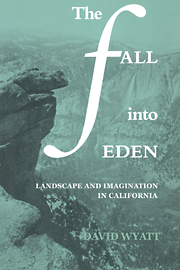Book contents
- Frontmatter
- Contents
- List of illustrations
- Acknowledgments
- Prologue: The mythology of the region
- 1 Spectatorship and abandonment: Dana, Leonard, and Frémont
- 2 Muir and the possession of landscape
- 3 King and catastrophe
- 4 Mary Austin: nature and nurturance
- 5 Norris and the vertical
- 6 Steinbeck's lost gardens
- 7 Chandler, marriage, and “the Great Wrong Place”
- 8 Jeffers, Snyder, and the ended world
- Epilogue: Fictions of space
- Notes
- Bibliography
- Index
8 - Jeffers, Snyder, and the ended world
Published online by Cambridge University Press: 18 December 2009
- Frontmatter
- Contents
- List of illustrations
- Acknowledgments
- Prologue: The mythology of the region
- 1 Spectatorship and abandonment: Dana, Leonard, and Frémont
- 2 Muir and the possession of landscape
- 3 King and catastrophe
- 4 Mary Austin: nature and nurturance
- 5 Norris and the vertical
- 6 Steinbeck's lost gardens
- 7 Chandler, marriage, and “the Great Wrong Place”
- 8 Jeffers, Snyder, and the ended world
- Epilogue: Fictions of space
- Notes
- Bibliography
- Index
Summary
In the middle of a difficult war, a poet recently married surveys a California hillside and dreams of building a house. The act once begun produces, in his wife's words, “a kind of awakening.” Peripatetic in mind and body, the poet now confirms the pleasures of manual labor and enjoys the disciplines of settlement. He begins to lead a new life and to write in a new measure. The poet feels that he has come to his “inevitable place.”
Robinson Jeffers in 1916; Gary Snyder in 1968. The two poets who have had the most to say about California landscape both ground their vision in the building of a house. Jeffers's Tor House became the work of many years; Snyder's Kitkitdizze still grows. One poet chose the wind and cold light of the Carmel headlands; the other, the hot, pine-studded foothills of the Sierra Nevada. Jeffers built a tower for his Una, won in 1913 after a six-year quest; Snyder built a sauna with his Masa, brought from Japan after a wedding on the lip of an active volcano. To each couple two sons were born. Both men chose unlevel ground where little would easily grow. Both chose granite, though Snyder's is mostly decomposed.
Locality: This is the dimension that binds. What divides these men–and this will be my argument–is their stance toward their moment in time. Snyder chooses his place with a commitment to his historical moment that Jeffers made in his life but avoided in his work. As an imagined place, Jeffers's California points beyond itself toward a network of timeless and even apocalyptic significance.
- Type
- Chapter
- Information
- The Fall into EdenLandscape and Imagination in California, pp. 174 - 205Publisher: Cambridge University PressPrint publication year: 1986

